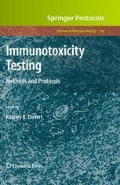Abstract
The sheep erythrocyte T-dependent antibody Response (TDAR) evaluates the ability of animals sensitized in vivo to produce primary IgM antibodies to sheep erythrocytes (sRBC). The assay enumerates the number of antigen specific IgM antibody producing cells in the spleen. When exposure to the test material takes place in vivo, as does sensitization, the actual quantification of the number of antibody producing cells occurs ex vivo. Following the animal being euthanized, a single cell suspension of spleen cells is prepared. These spleen cells containing the IgM secreting plasma cells are incubated in a semisolid matrix of agar, sheep erythrocytes, and guinea pig serum as a single cell layer between a Petri dish and glass cover slip. After a 3 h incubation period, lysis of sRBCs around each of the IgM secreting antigen specific plasma cells results in the formation of a clear plaque, which can easily be counted. The TDAR has been found to be the most sensitive functional assay for evaluating effects on the immune system, particularly the humoral immune component. The TDAR to sheep erythrocytes still remains the gold standard for evaluating the potential adverse effects of xenobiotics on the immune system.
Access this chapter
Tax calculation will be finalised at checkout
Purchases are for personal use only
References
Jerne NK, Nordin AA, Henry C (1963) The agar plaque technique for recognizing antibody-producing cells. In: Amos B, Koprowski H (eds) Cell-bound antibodies. Wistar Institute Press, Philadelphia, PA, pp 109–125
Hubner KF, Gengozian N (1968) Critical variables of the Jerne plaque technique as applied to rodent antibody-forming systems responding to heterologous red cell antigens. J Immunol 102:155–167
Luster MI, Munson AE, Thomas PT, Holsapple MP, Fenters JD, White KL Jr, Lauer LD, Germolec DR, Rosenthal GJ, Dean JH (1988) Development of a testing battery to assess chemical-induced immunotoxicity: National Toxicology Program’s guidelines for immunotoxicity evaluation in mice. Fundam Appl Toxicol 10:2–19
White KL Jr, Gennings C, Murray MJ, Dean JH (1994) Summary of an international methods validation study, carried out in nine laboratories, on the immunological assessment of cyclosporine A in the Fischer 344 rat. Toxicol In Vitro 8:957–961
Dayan AD, Kuper F, Madsen C, Smialowicz RJ, Smith E, Van Loveren H, Vos JG, White KL Jr (1998) Report of validation study of assessment of direct immunotoxicity in the rat. Toxicology 125:183–201
Loveless SE, Ladics GS, Smith C, Holsapple MP, Woolhiser MR, White KL Jr, Musgrove DL, Smialowicz RJ, Williams W (2007) Interlaboratory study of the primary antibody response to sheep redblood cells in outbred rodents following exposure to cyclophosphamide or dexamethasome. J Immunotoxicol 4(3):233–238
Temple L, Kawabata TT, Munson AE, White KL Jr (1993) Comparison of ELISA and plaque-forming cell assay for measuring the humoral immune response to SRBC in animals treated with benzo(a)pyrene or cyclophosphamide. Fundam Appl Toxicol 21:412–419
Smith HW, Winstead CJ, Stank KK, Halstead BW, Wierda D (2003) A predictive F344 rat immunotoxicology model: cellular parameters combined with humoral response to NP-CγG and KLH. Toxicology 194:129–145
Gore ER, Gower J, Kurali E, Sui JL, Bynum J, Ennulat D, Herzyk D (2004) Primary antibody response to keyhole limpet hemocyanin in rat as a model for immunotoxicity evaluation. Toxicology 197:23–35
White KL Jr, Sheth CM, Peachee VL (2007) Comparison of primary immune responses to SRBC and KLH in rodents. J Immunotoxicol 4(2):153–158
Acknowledgments
Supported in part by NIEHS Contract ES 05454.
Author information
Authors and Affiliations
Corresponding author
Editor information
Editors and Affiliations
Rights and permissions
Copyright information
© 2010 Humana Press, a part of Springer Science+Business Media, LLC
About this protocol
Cite this protocol
White, K.L., Musgrove, D.L., Brown, R.D. (2010). The Sheep Erythrocyte T-Dependent Antibody Response (TDAR). In: Dietert, R. (eds) Immunotoxicity Testing. Methods in Molecular Biology™, vol 598. Humana Press. https://doi.org/10.1007/978-1-60761-401-2_12
Download citation
DOI: https://doi.org/10.1007/978-1-60761-401-2_12
Published:
Publisher Name: Humana Press
Print ISBN: 978-1-60761-400-5
Online ISBN: 978-1-60761-401-2
eBook Packages: Springer Protocols

